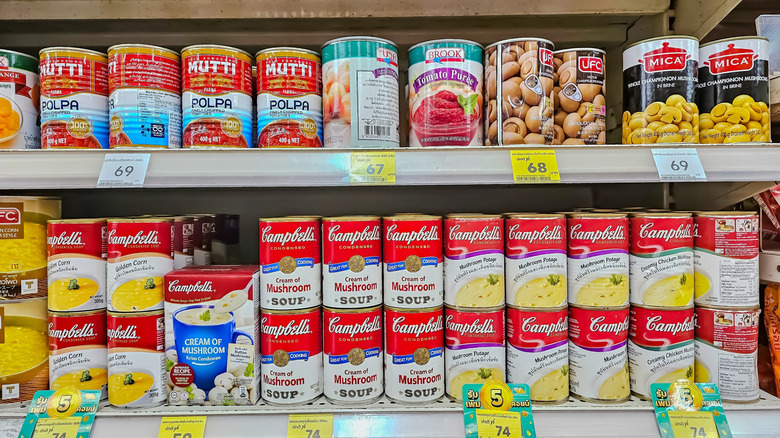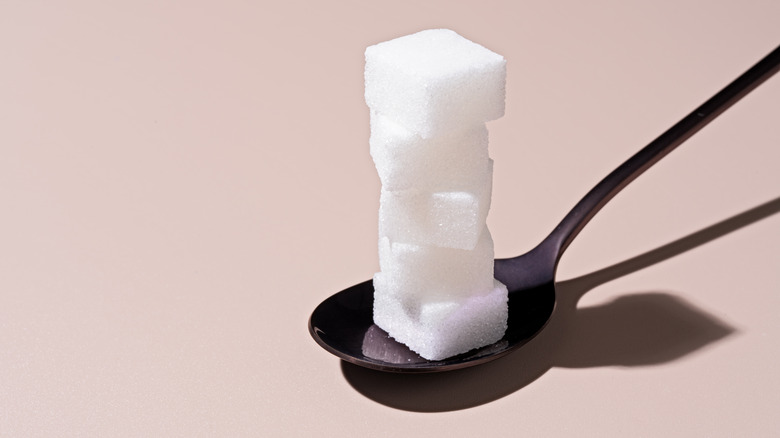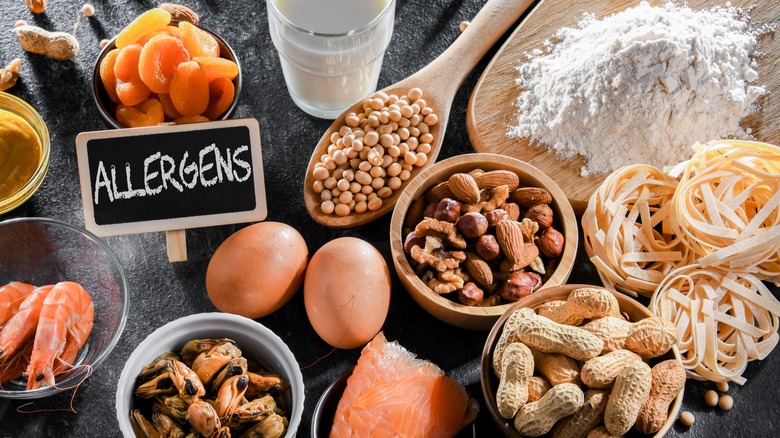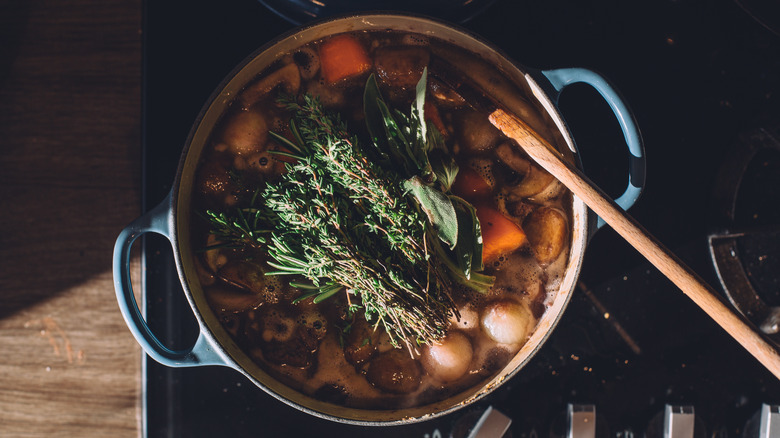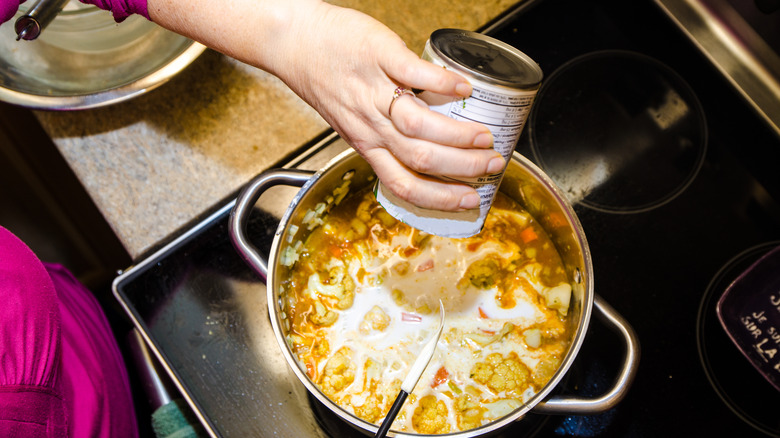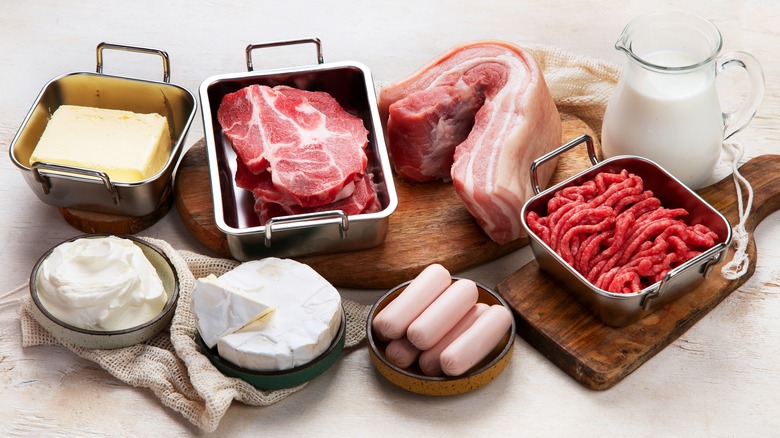What To Know Before Buying Canned Soup
We may receive a commission on purchases made from links.
Canned soup is more than a mere can of soup. It can be an entire meal in a can, the secret ingredient in your favorite family casserole recipe, or even repurposed to make delicious pasta sauces (try it, you'll like it). Today, you can find a wide variety of canned soups at your local grocery store, in a variety of flavors, and suitable for almost any type of diet.
In 1897, a chemist at Campbell Soup Company named Dr John Dorrance discovered a technique that would change the face of canned soup forever: condensing. Soup costs were high — you might scoff at it now, but 30 cents for a can of soup was no joke back in the 1800s — and this was mostly due to the size and weight of the cans. Dr. Dorrance, who later became the president of Campbell Soup Company, discovered that he could remove most of the water from the soup by condensing it, which allowed it to be packaged in smaller cans. In turn, the price dropped from 30 cents per can to just 10 cents.
While canned soup has been a staple in the American home for well over a century, the processes and ingredients used to make canned soup have changed over the years. Today, we have so many choices that picking out a simple can of soup can be overwhelming. Here are some things to know before you reach for your next can of soup at the grocery store.
Canned soup can be sky-high with sodium
Watching your salt? Watch your label. Canned soup often contains excessive levels of sodium (that's why it tastes so good — all that salt is pretty tasty). The use of sodium is two-fold. First of all, humans like salt and salty foods, so sodium is often added to enhance flavors. Secondly, sodium is a preservative, keeping the canned soup fresh longer. People need sodium — it helps us maintain the proper amount of fluids in our body and aids in using our muscles. However, in large doses, it can be dangerous, resulting in stroke, heart disease, and high blood pressure.
The American Heart Association suggests we eat no more than 1500 milligrams of sodium daily (for some perspective, that's just over half a teaspoon of salt), but some soups take up a large chunk of our daily sodium requirements. For example, one serving of Campbell's condensed cream of chicken soup has 870 milligrams of sodium for one serving (that's more than half of the daily recommended amount). Progresso has a tomato basil soup with 690 milligrams. The good news is that brands have taken note as we've learned about the dangers of consuming too much sodium. Today, you can find various low-sodium soups on the market. Campbell's answered the call for low-sodium cream of chicken soup by bringing an unsalted cream of chicken soup to store shelves. The unsalted version comes in at just 60 grams of sodium per serving. Progresso has also stepped up, offering a reduced-sodium tomato basil soup option with 480 milligrams.
Some soups are high in sugars
We don't typically think of soup as sweet and sugary, but it's common to find heaps of added sugar in your canned soup. Sugar is typically added to soups with a sweeter profile, like tomato soup or squash-based soups. There's a reason that the pumpkin butternut squash bisque at Trader Joe's is so craveable — it's got 4 grams of added sugar to sweeten it up. And while 4 grams doesn't seem like much, 4 grams is the equivalent of a teaspoon of sugar. When we think about all the processed foods we come across daily, the added sugars can quickly pile up.
The American Heart Association recommends no more than six teaspoons a day for most women and nine teaspoons a day for most men. If you're trying to cut back on sugar, don't ignore the nutrition labels on canned soup. For example, one serving of Panera's autumn squash soup, which is seasonal and available at most grocery stores, contains a whopping 16 grams of added sugar per serving. While the soup itself is probably delicious and popular for a reason, it's worth considering if those four teaspoons of sugar are worth it before making your purchase.
Some canned soups contain BPA in the lining of their lids
BPA, or bisphenol A, is a chemical that has been used to make plastics since the 1950s. It has recently been linked to certain health problems, such as cardiovascular disease and behavioral issues in children. While considered safe in small amounts, it's been widely phased out of food containers due to its known health concerns and consumer uncertainty about its safety. Despite being removed from many plastics and containers, it can still be found occasionally in cans and jars used for packaging food.
Trader Joe's, which is well-known for taking consumer concerns seriously and openly sharing its product ingredients and sources, has admitted that you can find BPA in some of its jarred products (Trader Joe's sells lots of canned goods, and these do not have BPA — just the jarred food). However, the company claims it covers the BPA with a lining so it never touches the food. Campbell's has taken a similar stance, being transparent and sharing that it has removed BPA from most of its packaging, but it is still found in some small components used for its canned products. Campbell's claims to be looking for alternative packaging. Progresso offers BPA-free cans and says it is looking to continue transitioning from BPA. Amy's has a strong stance on BPA, saying none of its cans include it. If purchasing BPA-free packaging is important to you, you might want to look into brands individually for their stance on BPA before purchasing.
Some soups are hiding common allergens
If you're dealing with food allergies or sensitivities, it's likely that reading nutrition labels is already second nature for you. If not, you'll want to start checking those labels now — some soups might be hiding unexpected ingredients that can trigger food allergies. 90% of food allergies are caused by just eight foods: milk, peanuts, eggs, soy, tree nuts, wheat, fish, and shellfish — and many of these foods can be found in your can of soup.
Gluten (which comes from wheat, a top food allergen) is a common canned soup ingredient. Wheat is often used for noodles, but you can also find it in the flour used as a thickener of many cream-based soups (and if it's cream-based, that means there's likely dairy in it, too — another common allergen). There is some good news here, though. Brands have taken heed of consumers' allergies and sensitivities, and today, you can find many allergy-friendly canned soup options. Progresso's gluten-free cheese and broccoli soup may be a good option, and Campbell's also has a line of gluten-free products. Health food and specialty stores will often stock allergen-free foods as well.
You don't have to serve canned soup the way it is
Canned soup is an easy meal just the way it is, but there's no reason to serve it as it comes in the can when you can turn it into something spectacular by adding extra ingredients and prepping it to your liking. Raid the garden and the fridge (a great way to use your frozen leftover herbs) for foods that need to be used, items approaching their expiration date, or anything that looks tasty to take your store-bought can of soup to the next level.
Need some inspiration? Keep it easy and make it cheesy by stirring in grated cheese as your soup heats on the stovetop. Top it off with grated cheese for a savory and satisfying serving of soup. Want to add a nutritional boost and use all that spinach for once? Stir it into your soup. Chop up fresh herbs to sprinkle over your soup for a kick of extra flavor. And that leftover chicken sitting in your fridge? Cut it into bite-sized pieces and let it stew in your pot of soup until it's been heated all the way through for an added protein boost.
There is a soup for everyone
Canned soup has changed with the times, sprouting from just one offering of canned soup — Beefsteak Tomato – into a giant industry worth over 4.5 billion dollars. The success of the canned soup market has been spurred by consumers' busy lifestyles and the need for convenient food. Today, you can find a can of soup you like, no matter what your dietary needs or preferences, like keto, high in fiber, Pacific Foods' vegan lentil and vegetable soup, or an Amy's organic split pea soup (or all of the above?). Or maybe you prefer your soup cold (like Julia Child's favorite)? There's a soup for that, too.
Some brands have developed a reputation for feeding everyone at your table despite food allergies, dietary restrictions, and health-conscious habits (and if you find a soup you love, be sure to stock up so you always have it in your pantry). You might have to look a little further than the shelves of your local mainstream grocery store to find your perfect can of soup, but it probably exists. Specialty and health food stores cater to dietary niches and are a good place to start. If you don't find what you need in person, take your search online — there are websites dedicated to selling canned soup.
Some soups are high in saturated fat
Cheese and butter make great soup ingredients (yum), but many dairy-based canned soups can be high in saturated fat. The American Heart Association's recommended daily intake of saturated fats for a person eating 2,000 calories a day is about 13 grams. If you're trying to avoid excessive saturated fat, look for canned soup options with less than 4 grams per serving, like a Campbell's roasted beef tip and vegetable soup with 1 gram of saturated fat per serving. Also, you can try avoiding the types of soups that generally have a higher saturated fat profile. This might include beef stews, broccoli cheddar soups, and loaded baked potato soups. If the soup's name starts with "creamy," be sure to scan that label for the saturated fat content.
Of course, sometimes we're looking for a bowl of soup to satisfy the soul, and the soul might not be interested in things like saturated fat. It's important to consider the bigger picture and your overall dietary patterns when making food choices. Rather than focusing on individual foods, consider implementing a balanced approach to diet. So if you really want Progresso's three cheese tortellini in a creamy soup, it might be okay to go for it — just load up on some healthy veggies and balance the rest of the meals you eat that week.
